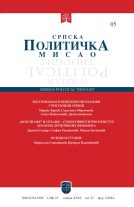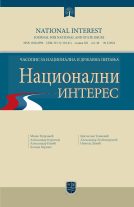- Home page
- Researchers
- Rajko Petrović
Rajko Petrović

A MODEL FOR IDENTIFYING SEPARATIST TENDENCIES: A PRACTICAL AND THEORETICAL APPROACH
Looking at the evolutionary process from the original human community to the present day, people have constantly sought freedom. Thus far, the best organizational solution to achieve such a need has been found in the formation of the state, as the key guarantor of the collective’s survival. However, there are numerous collectives that currently lack their own state, and their rights are partially or (not) fully recognized within another state. Many achieve their struggle for freedom through peaceful means, negotiating with official institutions or changing the entire state system in a democratic and legal manner. However, there are also groups that endanger the territorial integrity and sovereignty of their parent states, and in order to achieve their interests, use violent means, thereby threatening peace, stability, and security. The primary goal of this study is to develop a general model that might enable the identification of separatist tendencies in sensitive areas of the world, regardless of the form of state organization. Additionally, the application of the model will be demonstrated through the example of the Republic of Serbia, one of the states with experience in combating separatist tendencies.

THE ROLE OF THE AUTHORITARIAN FUJIMORIST REGIME IN PERU IN SUPPRESSING THE ACTIVITIES OF THE LEFT-WING GUERRILLA GROUPS SENDERO LUMINOSO AND TÚPAC AMARU REVOLUTIONARY MOVEMENT
The subject of this research is the analysis of the role played by the Fujimorist regime in Peru, i.e. the rule of Alberto Fujimori in that Latin American country from 1990 to 2000, in suppressing the activities of the left-wing, i.e. Marxist-Leninist guerrilla groups Sendero Luminoso and the Túpac Amaru Revolutionary Movement which represented the main security threat in the observed area from the 1980s to 2000. The basic assumption is that the Fujimorist regime, due to its authoritarian character, had greater success in the fight against Sendero Luminoso and Túpac Amaru Revolutionary Movement than was the case with the democratic regime before it, primarily due to the greater use of violence and brutal methods of suppressing guerrilla activity. The results of the research showed that it was in the period of the 1990s that the greatest successes of the state in the fight against the observed guerrilla groups were achieved, as evidenced, among other things, by the arrest of Sendero Luminoso leader Abimael Guzmán in 1992 and the complete neutralization of the Túpac Amaru Revolutionary Movement in 1997. The conclusion of the research is that the observed case is another indicator that authoritarian regimes, more prone to violence and less interested in human rights and freedoms, tend to solve security problems more quickly and efficiently, such as the activities of guerrilla groups, but also that security risks related to the activities of Sendero Luminoso in Peru still exist, although they are much smaller than before the 2000s. In the research, we used the historical method, the case study method and comparative analysis.

CONTRIBUTION OF LIBERALISM TO THE UNDERSTANDING OF THE STATE – CRITICISM OF WELFARE STATE
Welfare state was one of the most important political and economic projects of the twentieth century. Its development has contributed to the spread of communism in the east and the manifestation of certain weaknesses of the market economy model in the west. After the great economic crisis of the 1930s, which broke out in the United States and expanded globally, political and economic thinkers began to search for a model that would be able to correct the weakness of the market. This led to the emergence of Keynes' theory, which in several decades later, in its various modalities, managed to survive in practice. However, although with its strong social component this model has gained millions of people around the world, over time, it began to show his weaknesses. The state of well-being in time demanded a growing degree of state influence in economic flows, which has suppressed competition, led to inefficiency, a brazen bureaucratic apparatus and a recession. Already at the end of the 1970s, the Western world was spattered by a wave of neoliberalism - that is, libertarianism. Neoliberal waves in the Western world had two main directions - reganism and tatcherism. Ronald Regan and Margaret Thatcher were the first Western leaders to dare to embark on a decommissioning of the state of well-being. They unquestionably accepted the proposals of neo-liberal thinkers, seeing the cutting of state expenditures a way to bring the economy out of the recession. Thanks to the criticism of the welfare state at the academic level by major economic thinkers – like Hayek, Nozick, Friedman and others, and their promotion of the liberal market, the Western world is gradually turning to the decay of the state of welfare state. After the collapse of the Eastern bloc, and the collapse of socialist and communist projects, the liberal model of the market economy imposed itself as a winner in the ideological and practical sphere.

EUROREGIONS – THE FUTURE OF THE EUROPEAN UNION?
The subject of the analysis of this work are Euroregions as specific forms of transnational cooperation in the European Union. Over the past decades, the European Union has been working intensively to implement the principles of decentralization, that is, to bring the authorities understood as service providers to citizens. Strengthening it’s regional capacities is one of the steps taken by the European Union. In this context, Euroregions should also be seen as forms of cooperation between different European nations. In addition to the description of some of the existing Euroregions and their advantages, the aim of this paper is to understand the significance of the Euroregion for the survival of the idea of a unified Europe, as well as to observe the same as possible alternatives between the two models of the organization of government that are imposed today – globalist and national. In this context, we will consider further the possibilities of developing the concept of the Euroregion and the obstacles that can be faced in the future. In theory, we will use the theory of regionalization and regionalism, and in terms of methods, we will use the historical method, the case study method, the statistical and comparative method.

ANALYSIS OF THE WORK OF REGULATORY BODIES IN REGIONAL DEVELOPMENT AREA IN THE REPUBLIC OF SERBIA: CASE OF THE NATIONAL REGIONAL DEVELOPMENT AGENCY
The Republic of Serbia belongs to the ranks of European countries with the greatest disproportion of the regional development of its parts. It is therefore important that the state insists on strengthening the existing ones and establishing new regulatory bodies that would deal with, within its competences, the problem of balanced regional development. One of the most important institutions in this domain in the Republic of Serbia is the National Agency for Regional Development (NARR). Consequently, the work will focus primarily on the analysis of the concept of regulatory bodies (in particular agencies), as well as on the analysis of the nature of regulation itself, and then the focus of the analysis is the National Agency for Regional Development - its legal nature, regulatory (and other ) function it performs, as well as consideration of its previous work and possibilities for its improvement.
